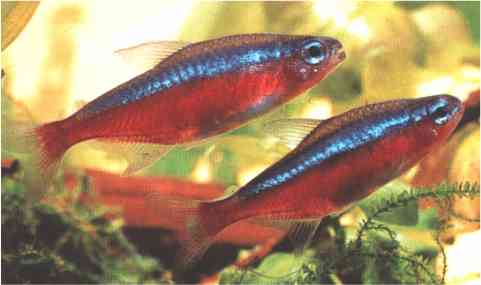Tetra - Neon
Neon Scientific Name: Paracheirodon innesi
Mon, 25th November, 2024 - 9:43 pm GMT
Sponsor Ads:

Alternative Name
Neon Scientific Name: Paracheirodon innesiBasic Info
The Neon Tetra is a brightly colored small fish. They rarely exceed four cm in length, averaging one and a quarter to one and a half inches in length, with males being slightly smaller than females. Females also have a rounded belly, while males are described as being more 'straight'. They are named 'neon' because the blue green line that runs from their eye to their tail reflects in a way similar to neon. The female's line will have a noticeable kink in it. The function of this line is to allow other Neon Tetras to see each other in dim or dark waters. The effect of this line in an aquarium is nothing less than beautiful, particularly when they are schooling. The body of the Neon is brightly colored, with a silver fronted lower body. Their fins are typically clear, though the base of the caudal fin is a brilliant red.
Health
Larger fish often eat Neon Tetras; therefore, they should be kept with fish of similar size. Never keep them with angelfish, as angelfish are natural predators of Neon Tetras. Breeding The breeding of Neon Tetras is difficult. The breeding aquarium should be set with a pH of slightly below 7. This is lower than the normal pH recommended for a general Neon tank (6 to 6.5). Light must not be too bright, or mating will not occur. Water temperature should be set at 72 degrees Fahrenheit. If the temperature varies from this, they will not mate or lay eggs. If breeding does occur, the female will lay approximately 130 eggs. Unfortunately, the percentages of eggs that hatch are low. Eggs are prone to being eaten by parents, so it is recommended that the parents be removed immediately after they are laid. The eggs will hatch after one day. Newly hatched Neons can be fed with artemia nauplii or other small live food. The newly hatched larvae are not free swimming until they are approximately five days old.Habitat
Fresh water fishBehavior
The Neon Tetra is a very docile fish. They are peaceful and do not exhibit aggression to other fish. They are a schooling fish and should always be kept in groups. Solitary neon tetras will become very timid and withdrawn. It would be best to keep them with similarly sized fish, as larger fish tend to eat them. In the wild, Neons will eat insects, insect larvae and aquatic plants when no insects are available.Some keepers of Neon Tetras hold that the tubifex worm is their food of choice. The Neon Tetra originates in the Amazon Rivers of South America, though they were initially discovered in quieter rivers of Peru. They are also seen in ponds, wetlands and quiet rivers containing blackwater and decomposing plants. Most of the Neon Tetras seen in pet stores today are captive bred, but their captive environment should imitate their natural surroundings. It is recommended to decorate their tanks with driftwood, rocks and live plants. They do best in temperatures of approximately 78 degrees Fahrenheit and pH levels between 6 to 6.5. Neons prefer to school in the middle range of the tank. Neon tetras are sensitive to water quality. Since water quality in beginner aquariums may be suspect they may not be the best choice for absolute beginners.Origin
South AmericaHistory
The Neon Tetra is a peaceful friendly fish that is seen in many community tanks. They are one of the most common aquarium fish in the world.Common Foods
The captive Neon Tetra will eat flake and freeze dried foods, but also really seems to enjoy several live foods such as glass worms, tubifex worms, bloodworms, and brine shrimp. They will usually eat frozen varieties of these live foods as well as frozeSponsor Ads:
"When you penetrate deeply into a country, it is serious ground. When you penetrate but a little way, it is facile ground." -- Sun Tzu, The Art of War
Tetra - Neon
Coded by: BGID® | ALL RIGHTS RESERVED Copyright © 2000-2024
Disclaimer | Privacy | Report Errors / Contact | Credits









 Beware the new Naval power, they are planning to come on stream with big naval might to match their ground forces. Chinese Aircraft Carrier - Chinese Navy
Beware the new Naval power, they are planning to come on stream with big naval might to match their ground forces. Chinese Aircraft Carrier - Chinese Navy  versus
versus 
 versus
versus  This Thread is about the North Korean Military itself - the kind of army, navy, and air force they have.
This Thread is about the North Korean Military itself - the kind of army, navy, and air force they have. 
 versus
versus  versus
versus 
 versus
versus  versus
versus